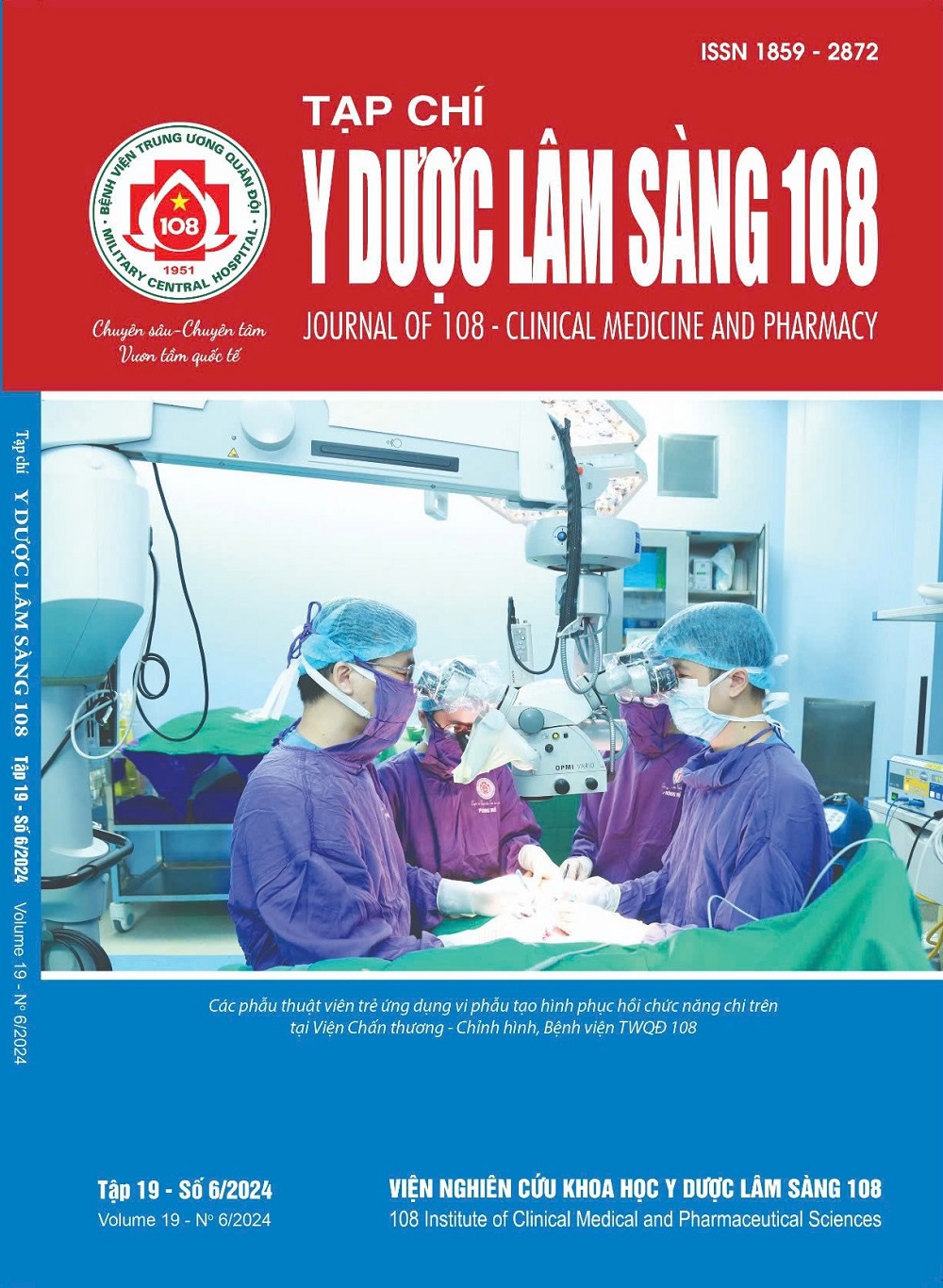Short-term outcomes of anatomical hepatectomy to treat hepatocellular carcinoma at 175 Military Hospital
Main Article Content
Keywords
Abstract
Objective: Short-term outcomes of anatomical hepatectomy to treat hepatocellular carcinoma at 175 Military Hospital. Subject and method: A descriptive, retrospective combined prospective study on 58 patients undergoing anatomical hepatectomy to treat hepatocellular carcinoma at 175 Military Hospital from 01/2022 to 5/2024. Result: Average age: 58.4 ± 13.0 years, age ≥ 60 accounted for 51.7%. 89.7% of patients were men. 60.3% cases were discovered liver tumors accidentally. The incidence of hepatitis B: 82.8%, average AFP index: 658.4 ± 984.4ng/ml. Preoperative computed tomography: Solitary tumor (81.0%), tumor < 5cm (46.6%), tumor > 5cm (53.4%), tumor > 10cm (13.8%), abdominal fluid (6.9%), portal vein thrombosis (3.4%). Preoperative liver function: Child-Pugh A 100%. Major hepatectomy 25.9%, minor hepatectomy 74.1%. The mean operation time was 164.7 ± 38.3 minutes. The mean blood loss was 254.8 ± 94.5ml, the need for blood transfusion was required in 41.4%. The average length of hospital stay was 9.7 ± 4.4 days. Postoperative complications (46.6%) included: Pleural effusion (31.0%), ascites (3.4%), bile leakage (3.4%), wound infection (3.4%), surgical wound dehiscence (5.2%). The classification of complications according to Clavien were: I (34.4%), II (3.4%), IIIa (3.4%), IIIb (5.2%). There was no perioperative mortality. Conclusion: Short-term outcomes of anatomical hepatectomy to treat hepatocellular carcinoma at 175 Military Hospital showed safety and should be performed routinely.
Article Details
References
2. Lu WP, Dong JH (2014) Hepatectomy for hepatocellular carcinoma in the era of liver transplantation. World J Gastroenterol 20: 9237-9244.
3. Allaire M, Goumard C, Lim C, Le Cleach A, Wagner M, Scatton O (2020) New frontiers in liver resection for hepatocellular carcinoma. JHEP Reports 2: 1-14.
4. Vũ Văn Quang (2018) Nghiên cứu ứng dụng kỹ thuật kiểm soát cuống glisson theo Takasaki trong cắt gan điều trị ung thư biểu mô tế bào gan tại Bệnh viện Trung ương Quân đội 108. Luận án Tiến sỹ, Viện Nghiên cứu Khoa học Y Dược học lâm sàng 108.
5. Yamamoto M, Terasaki K (2001) Effectiveness of systematized hepatectomy with Glisson’s pedicle transection at hepatic hilus for small nodular hepatocellular carcinoma: Retrospective analysis. Surgery Today 130: 443-448.
6. Dương Huỳnh Thiện (2016) Đánh giá kết quả sớm phẫu thuật cắt gan điều trị ung thư tế bào gan tại Bệnh viện Chợ Rẫy. Y học Thành phố Hồ Chí Minh 20, tr. 135-140.
7. Lê Văn Thành (2013) Nghiên cứu chỉ định và kết quả phẫu thuật cắt gan kết hợp phương pháp Tôn Thất Tùng và Lortat-Jacob điều trị ung thư biểu mô tế bào gan. Luận án Tiến sỹ, Viện Nghiên cứu Khoa học Y Dược Lâm sàng 108.
8. Shehta A, Farouk A, Elghawalby AN, Elshobary M, Aboelenin A, Fouad A, Ali MA (2021) Outcomes of Hepatic Resection for Hepatocellular Carcinoma Associated with Portal Vein Invasion. Journal of Surgical Research 266: 269-283.
9. Steven AC, Barnett CC, Abdalla EK (2018) Surgical management of potentially resectable hepatocellular carcinoma. wwwuptodatecom.
10. Tan Y, Wei Zhang, Li Jiang et al (2017) Efficacy and safety of anatomic resection versus nonanatomic resection in patients with hepatocellular carcinoma: A systemic review and metaanalysis. PLoS ONE 12.
 ISSN: 1859 - 2872
ISSN: 1859 - 2872
